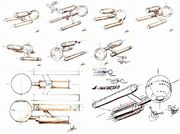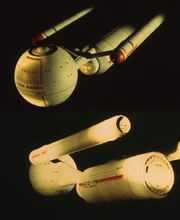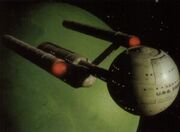(written from a Production point of view)
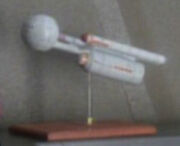
Daedalus-class display model
Perceived by the Star Trek production staff as having played a significant role in the early exploration-era of the United Federation of Planets, the designation "Daedalus-class" was only established in dialogue for the otherwise unfeatured USS Essex in the Star Trek: The Next Generation season five episode "Power Play". And while the appearance of USS Horizon was established as a display model in the Star Trek: Deep Space Nine first season episode "The Nagus", it should be noted that the link between appearance and class designation has never been established in canon. However, production staff fans, most notably Greg Jein, Doug Drexler and Michael Okuda (in his Star Trek Chronology and Star Trek Encyclopedia reference works in particular) have vigorously championed the appearance of the Daedalus-class – including that of USS Essex, being established as a class member in "Power Play" – as derived from a design concept by Star Trek: The Original Series Art Director Matt Jefferies.
As the official franchise has as of 2002 deemed the contents of Okuda's two works as "quasi-canon" (thereby becoming the only ones they consider as such from then on), it follows that the Daedalus-class appearance has attained this status as well. (Star Trek: The Magazine Volume 2, Issue 11, p. 71)
Design[]
According to the Encyclopedia (1999, p. 97), the, what was essentially conjectural, design of the Daedalus-class was "based on an early USS Enterprise design by Matt Jefferies and built by Greg Jein." Jefferies himself seriously considered his design as a possible contender at the time, as he deemed the sphere the best possible pressure vessel for use in a vacuum, but eventually dispensed with the design as being "too bulky", or as he had put it himself, "Then for the hull, I didn't really want a saucer because of the term 'flying saucer', and the best pressure vessel of course is a ball, so I started playing with that. But the bulk got in the way and the ball just didn't work. I flattened it out and I guess we wound up with a saucer!". (Star Trek: The Magazine Volume 1, Issue 10, pp. 25, 28)
Reference model[]
Greg Jein, out of his own volition, constructed an Essex reference model for Michael Okuda to photograph and photoshop, and who had it prominently featured in his works, firstly in his 1993 edition of the Chronology, and subsequently in the first, 1994 edition of the Encyclopedia, perpetuated as color photographs in all subsequent editions of both works. [1](X) Okuda has recalled,
"(...) Greg modeled the Daedalus for us for the Star Trek Chronology. When Doug and I were photographing it, I asked Doug to add a little bit of weathering detail to Greg's model to bring out a little more of the panel detail. We were thrilled to have a real Greg Jein model for the project, and Doug was just a bit nervous to be working on a model that had been created by one of the masters of the art. "I feel like I'm defacing a Greg Jein original," he said. I disagreed. "Look at it this way, Doug: You're actually *completing* a Greg Jein original." Faced with that unassailable logic, Doug went back to work, with beautiful results. Oh, and by the way, thanks again, Greg!" [2](X)
Okuda had the model, measuring about 20 inches in length, upon delivery originally labeled USS Horizon for its entry in the Chronology, before relabeling it on its bow as USS Essex (NCC-176), but has felt no need to change its registry nor the small name decal on the stern of the model, as he was aware that they would not be discernible in the small black and white pictures. Therefore the model was incorrectly labeled in the first 1994 edition of the Encyclopedia for its Essex entry – though he had the ship endowed with the intended "NCC-173" registry, in both the individual entry (p. 94) as well as in his starship list (p. 320) – , aside from having it featured as USS Archon as well (p. 14, though that ship was otherwise not established in canon as being Daedalus-class). Aside from the photos, the Encyclopedia also featured diagrams of the class by Drexler, which "(...) were drawn directly from Greg Jein's model". [3]
Nor has Okuda corrected this for subsequent editions of the Chronology/Encyclopedia, when he took new, additional color photographs of the model, but by careful angling and lighting, the registry for Essex has remained obscured. Interestingly, at the time the nacelles were equipped with spikes akin to those seen on the original Enterprise studio model in "The Cage". Apart from photographing the model, Okuda had Drexler also retouch the photos for representation in the Chronology/Encyclopedia by adding background and lighted windows (neither this model nor the later copies were equipped with an internal lighting rig), whereas for the later Chronology/Encyclopedia color editions, beauty stills of the model against planet backdrops were composited by Visual Effects Supervisor Gary Hutzel. (Star Trek Chronology (2nd ed., p. ix))
Production copies[]

The production-used Horizon model copy
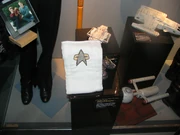
The second Horizon model copy at The Experience (lower right)
Additional castings were taken from the molds of this model and have been refurbished as USS Horizon, one minus the spikes and with an unchanged registry, and first appeared in Deep Space Nine as a model kept in Deep Space 9's classroom in "The Nagus", before being subsequently used as a desktop display model in Benjamin Sisko's office as well. ("Progress", et.al.) Okuda elaborated,
"There were at least two models of the Horizon/Essex. The first was the one that Greg built for the Chronology. I later asked Greg to make a casting of that model, so we could use it as set dressing in Sisko's office. I believe he made another casting for display at Star Trek: The Experience [remark: which he actually did, as the USS Horizon and where it was, as per plaque, specifically designated Daedalus-class [4]]. I may still have the original model somewhere, although I seem to recall it was damaged in an earthquake some years ago... The 'painted over stripes' were present on the cast resin copies. The original stripes were fairly thick graphic tape, so they showed up as ridges on the cast copies. Doug and I did the taping after Greg delivered the finished model. We also applied tape over the ridges on the copy in Sisko's office, at least partially, but I don't think we ever got a chance to tape the copy made for The Experience." [5](X) [6]
Okuda has relocated some of the (above featured) original photos he had taken of his model for the book, and had them featured on Drexler's blog(X) in March 2009. In 2015, Okuda relocated his model as well and sent newly-taken pictures of his model to Ben Robinson in a solicitation bid to have the design incorporated in Robinson's Star Trek: The Official Starships Collection partwork publication, which was actually honored two years later (see below). [7] While Okuda has retained ownership of the original reference model, [8] the current whereabouts of the Sisko and Experience display model copies are unknown, as they have not been sighted since.
CGI models[]
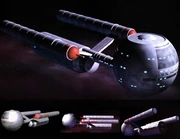
First CGI model for Fact Files/The Magazine
As an ancient, decommissioned ship-class in the history of Star Trek, no need was perceived to have any vessels of the class featured in any of the live-action productions as a full-fledged CGI model. Yet, need was perceived for one when the number of in-universe reference work publications started to proliferate in the late 1990s.
The first one was constructed as USS Horizon at either Digital Muse or Foundation Imaging at the behest of the aforementioned Associate Editor Ben Robinson for use in the British partwork publication Star Trek Fact Files, where it made its debut in, and on the cover of, Part 57, 1998. [9] The model made subsequent appearances in Fact Files' derivative publications Star Trek: The Magazine Volume 1, Issue 16 (pp. 6, 34, 2000), and Star Trek: The Magazine Volume 3, Issue 9, p. 32 (2003). As the software package of choice for both digital effects companies at the time, the model has been constructed in LightWave 3D.
In 2003 Drexler, under his nom-de-guerre "Max Rem", constructed a second CGI model of USS Daedalus (NCC-129, and presumably the class-vessel) (β) for use in one of James Cawley's episodes of the fan series Star Trek: New Voyages, "Almost ten years ago I had built a rough and ready CG model of this Jefferies classic for the Star Trek: New Voyages episode "In Harm's Way"," stated Drexler on a later occasion, "The amazing Greg Jein had built a physical model of this ship for our use on Deep Space Nine, and it was seen in Captain Sisko's office through the run of the series. When it came time to bash out a CG model on my lunch break, I went down to set dressing and borrowed Greg's model from Laura. Now it sat on my desk, the best reference in the world, and I got to work. You'd love to spend a few days on something like this, but we were in the middle of making a TV show." [10](X) Drexler had likewise constructed his model in LightWave 3D, as he had learned to use the software package during his stay at Foundation Imaging a few years earlier.
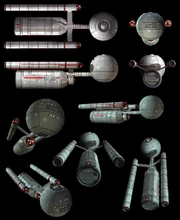
|
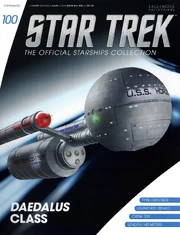
|
It has been Drexler's model that was later exclusively used in subsequent licensed print publications, such as the cover of the Star Trek: Vanguard novel Summon the Thunder – as USS Lovell (NCC-470) (β) – the Star Trek: Ships of the Line calendars and their book derivatives. [11](X) [12](X)
In 2017, a new CGI model was created for use with the Star Trek: The Official Starships Collection, by CGI artist Fabio Passaro. [13] This model incorporated higher resolution texturing and mechanical elements found on other ships of the era, such as the NX-class. This includes glowing nacelle grills, fore and aft phaser turrets and photon torpedo launchers, a hidden deflector dish, impulse engines (which are missing from the original studio models), and NX-style airlocks. Passaro's model was designed to "hint at a transitionary phase between Captain Archer's Enterprise, and Captain Kirk's Enterprise." His model was likewise constructed using LightWave 3D, as it was the software package of choice by his consigner, Eaglemoss Collections.
Legacy[]
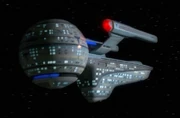
The protégé.
In the finale of Star Trek: The Next Generation, "All Good Things...", a hospital ship, the Olympic-class USS Pasteur, turned up that bore a striking resemblance with the Daedalus-class; this was by no means a coincidence, as it turned out that Drexler, Jein, and Okuda were not the only ones that were taken with Jefferies' original design. Like them, Pasteur designer and builder Bill George was an Original Series fan and an admirer of Jefferies, and had based his work on the same Jefferies design, as his predecessors had theirs.
If it had been up to Designer Doug Drexler, the Daedalus class would have been his starting point in designing the Enterprise NX-01 for the series Star Trek: Enterprise, "I like the NX-01, even though it was a frustrating experience. I’m a "canon" kind of guy. I would have liked to have seen the Daedalus style ship. You know... the sphere instead of saucer. The producers wanted it to be a saucer because they wanted it "recognizable"", [14](X) or as he had put it on another occasion, "In the Enterprise art department, we favored this design for the NX. Not a chance." [15](X) He was not alone in this regard as he explained on another occasion, "Mike Okuda and I pushed for it to be the basis of the NX, but the studio was afraid to abandon the familiar saucer config." Despite this he has added, "Ultimately we both very much like the NX we ended up with. It is highly thought out, and you can draw a line directly to Matt's TOS ship." [16]
Further reading[]
- Star Trek: The Official Starships Collection, issue 100, June 2017

